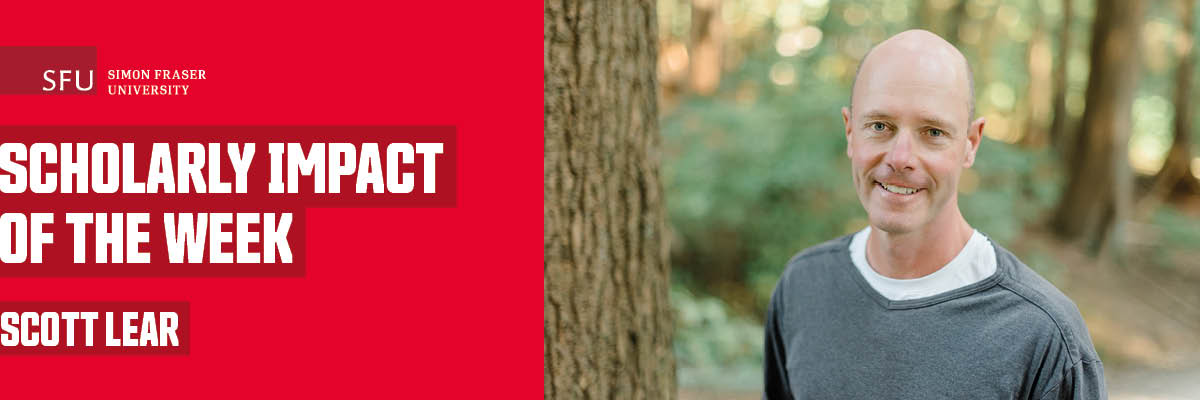
Simon Fraser University (SFU) professor Scott Lear is a health and lifestyle medicine expert in SFU’s Faculty of Health Sciences (FHS). He is also the Pfizer/Heart & Stroke Foundation Chair in Cardiovascular Prevention Research at St. Paul’s Hospital, and a member of the Division of Cardiology at Providence Health Care.
A leading researcher on the prevention of cardiovascular and other chronic diseases, Lear’s work focuses on supporting healthy lifestyles and improving access to timely health care. He also shares clear, concise information on health-related topics as a media expert, through his blog Feeling Healthy with Dr. Scott Lear and new podcast, How to Health, produced with FHS alumnus Christine Henderson.
One of Lear’s areas of study is investigating how the neighbourhood a person lives in can affect their health. For example, walkable communities with proximity to parks are associated with better mental wellbeing and lower risk of heart disease. Neighbourhoods with a higher density of fast food restaurants present a higher risk for obesity than those with access to fresh foods and grocery stores.
In a recent study, Lear and collaborators investigated how access to greenspace, and socio-economic status might work together to affect an individual’s risk of diabetes. They studied diabetes prevalence in 5125 individuals reporting across sub-neighborhoods in Hamilton and Vancouver, and created a combined socioeconomic/greenspace index of individual diabetes risk. Results provided strong evidence of an environmental component of risk not sufficiently explained by diet and physical activity. Findings also suggested that increasing urban greenspace may help reduce diabetes at the community level.
The study, Neighborhood Greenspace and Socioeconomic Risk are Associated with Diabetes Risk at the Sub-neighborhood Scale: Results from the Prospective Urban and Rural Epidemiology (PURE) Study, published in Journal of Urban Health, was an interdisciplinary collaboration with researchers from SFU, the Institute for Geography in Germany, Oregon State University and McMaster University. SFU geography professor Nadine Schuurman also contributed to the work.
We spoke with Professor Lear about his research.
Why did you choose to weigh socioeconomic factors and greenspace together?
We did consider a number of environmental factors in this study—such as proximity to grocery stores and fast food restaurants. Socioeconomic factors and greenspace had the strongest associations, which confirms that while environmental factors are important to consider, so is economic status.
How does the risk of diabetes vary between various neighbourhoods in Vancouver and Hamilton?
In both cities, the prevalence of diabetes tends to be higher in those neighbourhoods that have less greenspace and are more socioeconomically deprived.
Diabetes is on the rise in Canada, with 11.7 million living with diabetes or prediabetes. Why is this condition becoming more prevalent?
There are probably a few reasons. First, our population is aging and with age the chances of getting type 2 diabetes increases. Second, obesity has increased in recent decades and obesity is a strong risk factor for diabetes. And, a more recent theory is that our diet consists of more highly processed foods than before and it is believed that some of these foods and the packaging they come in may affect the body’s metabolism.
What are some of the characteristics of healthy communities? What should urban planners be aware of when designing communities?
In general, healthy communities are ones that prioritize the person and people. This can include making pedestrian crossings safer, and providing more infrastructure for walking, cycling and other active transport. Multi-density land use such as positioning residential and commercial areas in proximity promotes walking and cycling, as does access to greenspace. Access to amenities like grocery stores within walking distance promotes healthy communities. Providing well-lit pathways where people feel safe also promotes walking.
Your study offers a proven socioeconomic/greenspace index of individual diabetes risk across neighbourhoods that can be utilized in other cities around the world. Have you applied this model to other cities? Could it be re-worked to measure other health-related factors?
We haven’t yet applied this index to other cities and yes—it can be re-worked to measure other health-related factors.
For more information, visit Feeling Healthy with Dr. Scott Lear, and listen to the new podcast How to Health, produced with FHS alumnus Christine Henderson.
SFU's Scholarly Impact of the Week series does not reflect the opinions or viewpoints of the university, but those of the scholars. The timing of articles in the series is chosen weeks or months in advance, based on a published set of criteria. Any correspondence with university or world events at the time of publication is purely coincidental.
For more information, please see SFU's Code of Faculty Ethics and Responsibilities and the statement on academic freedom.